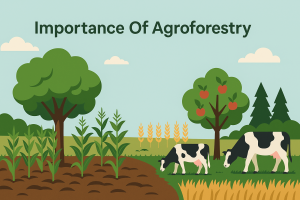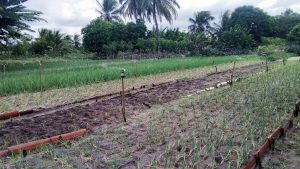Agroforestry is a dynamic, ecologically based natural resource management system that integrates trees, crops, and livestock on the same plot of land. It offers a sustainable and productive land-use system that benefits both farmers and the environment.
Agroforestry is increasingly recognized as a viable solution for climate change, food security, and biodiversity conservation. Agroforestry enhances soil health, controls erosion, and helps in carbon sequestration while increasing productivity.
This multifaceted system is adaptable to various regions and has been proven to improve livelihoods for millions of smallholder farmers. With rising environmental challenges, agroforestry is emerging as a critical tool for sustainable agriculture.
This article explores the 10 best importance of agroforestry, detailing their impact, benefits, and relevance in today’s world. Let’s dive into the reasons why agroforestry should be adopted globally.
Related: Best Revolver Herbicide Alternatives
10 Best Importance Of Agroforestry
1. Agroforestry Enhances Soil Fertility
Agroforestry plays a vital role in improving soil fertility through nitrogen fixation by leguminous trees. These trees convert atmospheric nitrogen into a usable form, enriching the soil naturally. Over time, agroforestry enhances soil structure and organic matter content.
The integration of trees and crops in agroforestry systems reduces the need for chemical fertilizers. Leaf litter from trees decomposes and adds essential nutrients to the soil. Through agroforestry, soil pH and nutrient balance are maintained more effectively.
Agroforestry systems support the growth of beneficial soil microbes and earthworms. These organisms help in aerating the soil and improving its water-holding capacity. Thus, agroforestry builds resilient and fertile soils for sustainable farming.
Pros:
- Boosts soil nutrients
- Reduces erosion
- Increases organic matter
- Promotes soil microbes
- Decreases chemical use
- Enhances crop yield
- Improves soil texture
Cons:
- Initial labor-intensive
- Needs space
- Slow nutrient release
2. Agroforestry Increases Biodiversity
Agroforestry enhances biodiversity by creating a habitat for various species of flora and fauna. The mixed planting system in agroforestry provides shelter, food, and breeding grounds. This promotes ecological balance and supports pollinators.
In agroforestry, multiple crop layers mimic natural forests, supporting a diverse ecosystem. Birds, insects, and small mammals thrive in such environments. Agroforestry encourages co-existence among different species, reducing dependence on pesticides.
Agroforestry systems also preserve indigenous and endangered plant species. The diverse plant life ensures genetic variety, which is essential for resilience. In this way, agroforestry contributes to long-term environmental conservation.
Pros:
- Attracts pollinators
- Supports wildlife
- Enhances ecosystems
- Reduces pesticides
- Preserves species
- Encourages coexistence
- Mimics forests
Cons:
- Complex management
- Pests may increase
- Competes with crops
3. Agroforestry Reduces Soil Erosion
Agroforestry helps prevent soil erosion through the use of deep-rooted trees. These roots bind the soil together, reducing the impact of wind and water erosion. Agroforestry ensures long-term soil stability and farm productivity.
In sloped areas, agroforestry provides excellent ground cover to slow down runoff. The canopy layer reduces the impact of raindrops, minimizing splash erosion. Agroforestry also increases soil infiltration capacity, reducing surface water loss.
Agroforestry creates buffer zones that act as windbreaks and filter strips. These barriers trap sediments and slow down water movement. As a result, agroforestry reduces topsoil loss and improves land sustainability.
Pros:
- Binds soil
- Minimizes runoff
- Reduces splash erosion
- Slows wind
- Stabilizes slopes
- Increases infiltration
- Prevents degradation
Cons:
- May require terracing
- Tree competition
- Initial soil prep
4. Improves Water Management
Agroforestry contributes to better water management by improving water retention in the soil. Tree roots in agroforestry systems enhance groundwater recharge. This ensures water availability during dry periods.
The shade from trees in agroforestry reduces evaporation rates, conserving soil moisture. It helps regulate the microclimate, promoting steady water cycles. Agroforestry also filters pollutants and improves water quality.
Agroforestry buffers streams and rivers from agricultural runoff. These vegetative buffers prevent contamination and erosion near water bodies. In essence, agroforestry safeguards both quantity and quality of water resources.
Pros:
- Enhances retention
- Boosts recharge
- Lowers evaporation
- Regulates microclimate
- Filters runoff
- Improves quality
- Prevents erosion
Cons:
- Needs planning
- Might cause shade
- Can alter hydrology
5. Mitigates Climate Change
Agroforestry plays a crucial role in climate change mitigation by sequestering carbon dioxide. Trees in agroforestry absorb CO2 and store it in biomass and soil. This reduces the overall carbon footprint of agriculture.
Agroforestry systems act as carbon sinks while promoting biodiversity and resilience. The inclusion of perennial species enhances long-term carbon storage. Agroforestry also reduces emissions from synthetic fertilizers and tillage.
Agroforestry helps farmers adapt to climate variability by providing shade and regulating temperatures. These systems increase resilience against extreme weather. Overall, agroforestry is a sustainable solution to global climate issues.
Pros:
- Captures CO2
- Reduces footprint
- Increases resilience
- Promotes biodiversity
- Regulates temperature
- Stores carbon
- Decreases emissions
Cons:
- Slow impact
- Needs long-term view
- Land competition
6. Enhances Food Security
Agroforestry boosts food security by diversifying production on the same land. Farmers can harvest fruits, nuts, timber, and medicinal plants alongside staple crops. This variety ensures year-round food and income.
Agroforestry systems reduce the risk of total crop failure by spreading the risk across species. When one crop fails, others provide a safety net. This approach enhances food stability and nutrition.
Agroforestry increases access to high-value products that improve household diets. Tree crops often require less input but yield nutritious food. Consequently, agroforestry strengthens food security at both household and community levels.
Pros:
- Diversifies harvest
- Reduces risk
- Enhances nutrition
- Supports income
- Offers variety
- Year-round supply
- Low input needs
Cons:
- More planning
- Skill-intensive
- Seasonal output
7. Provides Economic Benefits
Agroforestry opens up multiple income streams through diverse products like timber, fruits, and herbs. This system maximizes land productivity without compromising sustainability. Agroforestry increases profitability for smallholder farmers.
By reducing dependence on external inputs, agroforestry lowers operational costs. Natural fertilizers and pest controls help farmers save money. Agroforestry also provides opportunities for local employment in nurseries and processing.
Agroforestry encourages market development for niche and high-value products. This helps build rural economies and resilience. With proper planning, agroforestry can significantly improve economic stability.
Pros:
- Multiple income
- Low costs
- Job creation
- Boosts productivity
- Supports markets
- Rural development
- High returns
Cons:
- Market access needed
- Initial investment
- Complex logistics
8. Promotes Sustainable Land Use
Agroforestry encourages sustainable land management by balancing productivity and conservation. It allows for continuous use of land without depleting its resources. Agroforestry systems mimic natural ecosystems.
Through the integration of trees, agroforestry prevents land degradation. It promotes long-term soil fertility and biodiversity. Agroforestry supports sustainability by reducing deforestation and overgrazing.
Agroforestry ensures that land is used efficiently and responsibly. This system reduces the pressure on forests and marginal lands. Therefore, agroforestry plays a critical role in achieving land sustainability goals.
Pros:
- Efficient use
- Prevents degradation
- Mimics nature
- Reduces deforestation
- Maintains fertility
- Encourages conservation
- Promotes balance
Cons:
- Needs management
- Time-consuming
- Land conflict
9. Supports Livestock Integration
Agroforestry systems allow for the integration of livestock, enhancing productivity and ecosystem health. Trees provide shade, fodder, and shelter for animals. This leads to better animal welfare and production.
Agroforestry reduces the pressure on grazing lands by providing alternative feed sources. Trees like Leucaena and Calliandra offer high-protein fodder. Agroforestry optimizes the use of space and resources.
Agroforestry improves nutrient cycling through manure and litter decomposition. This enriches the soil and benefits plant growth. Thus, agroforestry fosters a balanced and integrated farming system.
Pros:
- Provides fodder
- Improves welfare
- Enhances space use
- Reduces pressure
- Boosts health
- Supports growth
- Balances systems
Cons:
- Animal control needed
- Grazing limits
- Complex planning
10. Strengthens Community Development
Agroforestry fosters community engagement through cooperative farming and shared resources. Communities benefit from joint training, marketing, and support networks. Agroforestry promotes knowledge exchange and collective growth.
Agroforestry strengthens social cohesion by encouraging collaborative decision-making. It creates jobs, especially for youth and women in rural areas. Agroforestry projects often receive support from NGOs and governments.
Agroforestry helps build resilient communities that are better prepared for economic and environmental challenges. The system empowers farmers through capacity building. Ultimately, agroforestry contributes to inclusive rural development.
Pros:
- Builds unity
- Empowers women
- Creates jobs
- Enhances resilience
- Supports training
- Promotes inclusion
- Encourages sharing
Cons:
- Needs coordination
- Cultural barriers
- Dependence risk
Importance Of Agroforestry FAQs
1. What is agroforestry?
Agroforestry is a sustainable land-use system that integrates trees with crops and/or livestock on the same land area.
2. How does agroforestry help the environment?
Agroforestry helps reduce erosion, improve biodiversity, sequester carbon, and enhance soil and water quality.
3. Can agroforestry improve income for farmers?
Yes, agroforestry offers multiple income sources including timber, fruits, fodder, and medicinal plants.
4. Is agroforestry suitable for smallholder farmers?
Absolutely, agroforestry is adaptable and ideal for smallholder farmers due to its resource-efficiency and productivity.
5. What types of trees are best for agroforestry?
Commonly used trees include nitrogen-fixing species like Leucaena, Gliricidia, and Calliandra.
6. What are the challenges in agroforestry?
Challenges include long gestation periods, complex management, and the need for technical knowledge.
7. How does agroforestry promote food security?
Agroforestry ensures diverse and continuous food supply while enhancing soil fertility and reducing crop failure risks.
Conclusion
Agroforestry is a powerful strategy for sustainable development, combining agricultural productivity with ecological benefits.
It improves soil fertility, biodiversity, and water management, making it a resilient approach in the face of climate change.
Agroforestry provides both economic and environmental rewards, supporting communities and future generations.
As a nature-based solution, agroforestry offers immense potential to transform land use across the globe. Embrace agroforestry today to secure food, livelihoods, and a healthier planet for tomorrow
Recent Posts
8-24-24 fertilizers are widely used in agriculture to improve crop yield, root development, and nutrient balance. Their high phosphorus and potassium content makes them ideal for establishing strong...
A healthy lawn requires the right balance of nutrients to maintain color, density, and resilience. Choosing the correct fertilizer directly impacts grass growth and soil health. The 16-4-8...